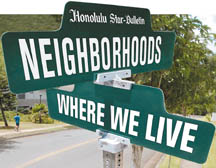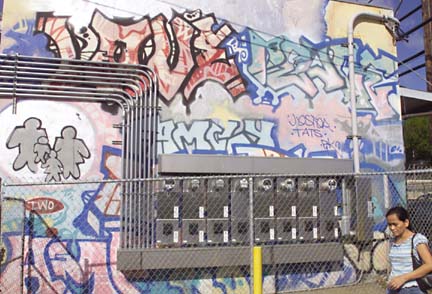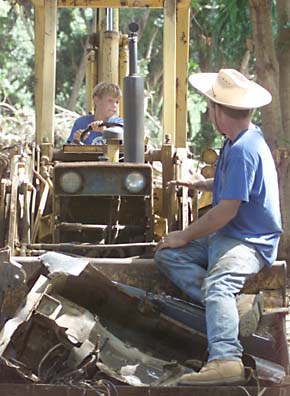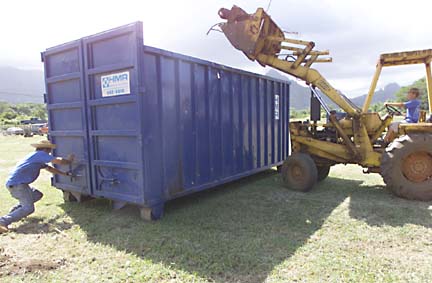
Waiahole is the beautiful and iconic setting of a desire to "keep the country country." A 1970s battle against its transformation from loi to putting greens defined a period in Hawaii when resistance to development accelerated and marked one of very few victories in defense of a rural lifestyle. The desire endures, but the struggle continues through sporadic forays to snatch away the water that feeds not only the valley's agricultural needs, but a whole ahupuaa ecosystem.
Such is not the case in Kalihi, where remnants of its rural past are overshadowed by a reputation of lawlessness and danger, in part due to the poverty and social status of its residents.
Kalihi | Waiahole
BACK TO TOP |
FL MORRIS / FMORRIS@STARBULLETIN.COM
Kalihi Valley residents Jesse Bayudan, left, Jerald Basques, Thaddius Ativalu, Taniela Prescott and Jevin Basques hang out atop the bus stop at the Kalihi Uka Pumping Station on Kalihi Street.
Bad reputation canŐt
blot valleyŐs ÔsoulŐResidents are proud of its
diversity and pockets of rural life
Mark Twain once described Kalihi Valley as the most enchanting valley in all the islands.
In the 1920s, newspaper accounts painted Kalihi Valley as a quaint, rural neighborhood dotted with pig farms, taro patches and the occasional cow.
Modern-day residents are still proud of its cultural diversity and pockets of picturesque, rural life that managed to survive the encroachment of condominium buildings.
It's still a neighborhood with "soul," said Ray Oshiro, a former Kalihi YMCA outreach director, in 1974.
Jory Watland, a Lutheran minister, said Kalihi is perceived as "a very dangerous place to live" in the media, but "it's the nicest place I could live."
Watland, who has lived in the valley since 1968, helped spearhead Kokua Kalihi Valley, a health and social services agency for which he served as executive director the past three decades. He resigned from the position in January.
Kalihi Valley is between the Kamehameha Shopping Center and Fort Shafter, and it's "a beautiful place, a great place," he said. "Some people say there are too many chickens and the streets are too narrow, but I think it's wonderful."
FL MORRIS / FMORRIS@STARBULLETIN.COM
The mural on the side of the New Polynesian Market on Kalihi Street is one of many that adorn buildings and walls in Kalihi Valley.
Watland added: "It has a wonderful community; it's like being in the country. It has a warm, accepting culture; it's not a culture of affluence, and people don't aspire to affluence. ... People are kind, and I don't have to worry about fences or alarms or a dog."
The Kokua Kalihi Valley has worked out of the Kalihi Valley Homes, a low-income housing project off Kamehameha IV Road, for 30 years, and "there has never been an incident in which a female staff member has ever been confronted at any time of the day or had to fear for her safety by anybody living in that facility," he said.
Watland said the immigrants who moved to Hawaii starting in the late 1960s as a result of a federal law promoting the reunification of families had a major impact on all Kalihi.
He said the school system never made a conscious effort to provide a staff trained to understand the language or culture of each new group of immigrants, and the social service system was equally lacking. The socioeconomic effects are still felt, he said.
The real estate boom in the early 1970s "meant many old families sold their property and moved to other districts," he said. Many of these families had provided community leadership, which has suffered since their leaving.
"That's tragic," Watland said.
"Very few people can be identified as (nonelected) community members who are spirited and who give their time and energy to building the community," he said.
BACK TO TOP |
CINDY ELLEN RUSSELL / CRUSSELL@STARBULLETIN.COM
Ian Towill, 11, takes instructions from his father, Rick Towill, while navigating a tractor. The pair were participating in a community cleanup of a park. More than 300 community members took part in the August cleanup, which cleared away nine abandoned vehicles, two large shipping containers' worth of metal, half of a container full of appliances, a small mountain of tires and tons of invasive vegetation.
Stubbornness wins
against developmentResidents banded together in
the '70s to fight landowners and
save their rural lifestyle
Visitors to a community taro patch in Windward Oahu's Waiahole Valley are usually greeted with a story of kalo pa'a, or the hard taro of Waiahole.
"I like to tie the story in to the struggles of the valley," said Waiahole taro farmer, educator and community activist Calvin Hoe. "To me the people of Waiahole are the hard taro -- pa'a kiki -- the stubborn people."
"Fundamentally, as far as land use, in terms of density, in terms of the rural lifestyle, it hasn't changed," said Waiahole papaya farmer David Chinen, who rattled off an array of crops grown in the valley: taro, sweet potato, ginger flowers, papaya, corn.
"I believe it's the people who live on the land who strongly believe in this and were willing to ... put their okoles on the line so that we could have this kind of lifestyle," Chinen said.
The stubbornness of the residents of both Waiahole and neighboring Waikane has kept both valleys free of the housing and golf course developments that were proposed for those areas during the past 30 years.
"So when the developer in the early '70s ... wanted to sell the valley and wanted to kick all the people out, the people said, 'No way, we ain't going,'" Hoe said. "To make a long story short, the people are still there. The developers are gone."
From the time the tenant farmers of the valley blocked roads, held protest signs and burned eviction notices delivered to them by then-owner Elizabeth Loy Marks, Waiahole has become a symbol and battle cry for anti-development fights across the state.
CINDY ELLEN RUSSELL / CRUSSELL@STARBULLETIN.COM
More than 300 community members took part in an August park cleanup, which cleared away nine abandoned vehicles, two large shipping containers' worth of metal, half of a container full of appliances, a small mountain of tires and tons of invasive vegetation.
"When the battle was fought, no one gave Waiahole any hope -- it was sort of a David-and-Goliath kind of situation," said Chinen, who has served as Waiahole-Waikane Community Association president since 1978.
"But the difference was that the people united and got a lot of support islandwide to keep this area in agriculture and rural."
That same obstinacy led community folk to challenge large landowners so that water could be restored to Windward streams that meander through Waiahole and other nearby valleys.
The water was diverted via the nearly 90-year-old Waiahole Ditch to Central and Leeward Oahu initially for sugar cane fields. Now, water is requested for not only agriculture, but golf course and housing needs as well.
In 1977 the state bought Waiahole Valley for $6.1 million and, during the next two decades, negotiated the terms of leases with the 100-family community. In 1998, Gov. Ben Cayetano presented the 93 leases that allow residents and farmers to continue living the rural lifestyle for the next 55 years.
Hoe said that had the Waiahole-Waikane battle not been successful, the valleys would have gone the way of Kalama Valley -- where protesters lost the 1971 fight to block the eviction of pig farmers to make way for housing development.
"The Windward side isn't growing as fast," Hoe said.







